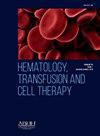Epidemiological characterization of chronic myeloid leukaemia patients at an oncologic centre: A retrospective observational study
IF 1.6
Q3 HEMATOLOGY
引用次数: 0
Abstract
Background
The chronic myeloid leukaemia population, treatment patterns and responses in Portugal are unknown. The aim of this study is to describe these features in a Portuguese reference centre.
Methods
A retrospective cohort study included patients with chronic myeloid leukaemia, treated between 2012 and 2022 at the Instituto Português de Oncologia of Porto. Data were obtained from the Cancer Registry of the institution and clinical records. Variables included demographic data, treatments administered, responses (hematologic, cytogenetic, major and deep molecular responses), adverse events, and survival. Patients without available data, those treated in a clinical trial context, and those admitted only for hematopoietic transplantation were excluded.
Results
Ninety-nine patients were included in this study, with a median age of 52 years (range: 7–84 years) at diagnosis. The first-line treatment was imatinib in 96 patients however 33 required second-line with dasatinib, and 17 discontinued treatment while maintaining response. Regarding responses, 95 (96 %) patients achieved cytogenetic response, 90 (94 %) achieved major molecular response, and 71 (72 %) achieved deep molecular response. At three months, the early molecular response rate was 77 %. At 12 months of treatment, of the 67 patients with response evaluation, 93 % achieved complete cytogenetic response and 49 % major molecular response. Both imatinib and dasatinib were well tolerated. The median follow-up was eight years. The five-year overall survival was 96 %.
Conclusion
This study is the first to characterize chronic myeloid leukaemia patients at a Portuguese centre. The patient characteristics, responses, and overall survival were within the expected range according to the literature. This study confirms the good prognosis of chronic myeloid leukaemia and the good responses using imatinib as first-line treatment.
肿瘤中心慢性髓性白血病患者的流行病学特征:一项回顾性观察研究
葡萄牙的慢性髓系白血病人群、治疗模式和反应尚不清楚。本研究的目的是描述葡萄牙参考中心的这些特征。方法一项回顾性队列研究纳入了2012年至2022年在波尔图Português肿瘤研究所接受治疗的慢性髓性白血病患者。数据来自该机构的癌症登记处和临床记录。变量包括人口统计数据、治疗、反应(血液学、细胞遗传学、主要和深层分子反应)、不良事件和生存率。没有可用数据的患者、在临床试验背景下接受治疗的患者和仅因造血移植入院的患者被排除在外。结果本研究纳入99例患者,诊断时中位年龄52岁(范围7-84岁)。96名患者的一线治疗是伊马替尼,但33名患者需要二线治疗达沙替尼,17名患者在维持疗效的情况下停止治疗。在应答方面,95例(96%)患者获得细胞遗传学应答,90例(94%)患者获得主要分子应答,71例(72%)患者获得深层分子应答。3个月时,早期分子反应率为77%。在治疗12个月时,67例患者中,93%达到完全细胞遗传学缓解,49%达到主要分子缓解。伊马替尼和达沙替尼耐受良好。中位随访时间为8年。5年总生存率为96%。结论:本研究是葡萄牙中心首次对慢性髓系白血病患者进行表征。根据文献,患者的特征、反应和总生存期均在预期范围内。本研究证实了慢性髓性白血病预后良好,伊马替尼作为一线治疗的疗效良好。
本文章由计算机程序翻译,如有差异,请以英文原文为准。
求助全文
约1分钟内获得全文
求助全文
来源期刊

Hematology, Transfusion and Cell Therapy
Multiple-
CiteScore
2.40
自引率
4.80%
发文量
1419
审稿时长
30 weeks
 求助内容:
求助内容: 应助结果提醒方式:
应助结果提醒方式:


